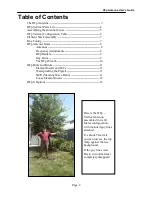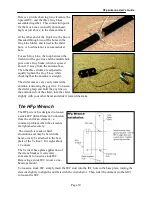
HFp Antenna User’s Guide
Page 5
Assembling the Antenna for Use
1)
First, screw the four feet into the ends of the aluminum base
pieces. After the HFp is set up, you can adjust these feet to make
it vertical, so it looks good.
2)
Place a lock washer on an IEC, and, from the top, insert the
IEC stud with the washer through the center holes in
both
base
plates.
Place a wing nut on the bottom of the IEC, align the plates to be
at right angles, and tighten the wing nut.
Screw the Base Insulator onto the top of the IEC.
3)
Place the Wrench on the top of the plate, with the mounting
hole aligned with the hole just offset from the center hole in one
of the base pieces.
Put a lock washer on an IEC, and put the IEC stud with the
washer through the Wrench hole and the Base Plate hole. Use
another IEC to position the wrench slot correctly over the IEC
removal hole.
4)
Use one of the Wing Nuts on the bottom of the Base Plate to
hold the IEC and Wrench in position.
5)
Screw an Inter-Element Connector (IEC) into the top of the
Base Insulator, and place the center conductor lug of the coaxial
pigtail (the white wire) over the IEC. (Under the IEC is also
OK)
6)
Put the coax shield lug (the black wire) on the ground stud,
put on one of the flat washers, then screw the wing nut on top of
it - not tight - you will need to take it off in a minute. Then place
the base on the ground or another flat surface.
7)
Take off the Ground Lug wing nut and put the lugs from each
of the three radial wires over the ground lug, then the second flat
washer on top, them put the wing nut on loosely.
Arrange the Radial Wires at about 120 degree equally-spaced
triangular pattern from the lug and tighten the wing nut. Leave
the wires spooled for now.
8)
Next, use the Configuration Table on the next page, or the
Laminated Card to determine which radiator elements you need
for the frequency band on which you wish to operate, and their
assembly sequence.
Get these elements, and the IECs, ready to assemble.






























